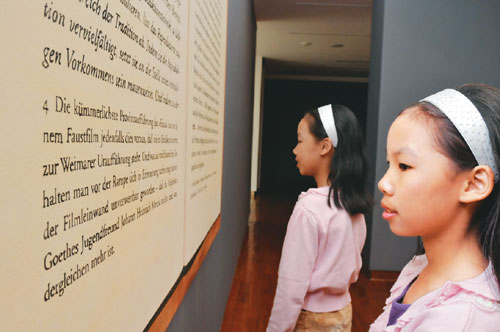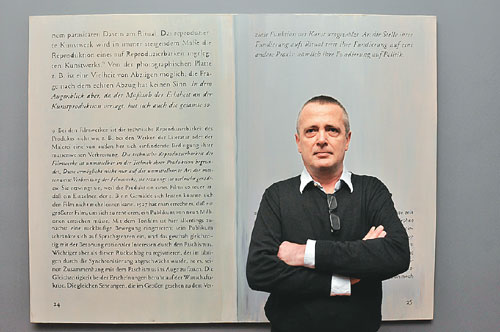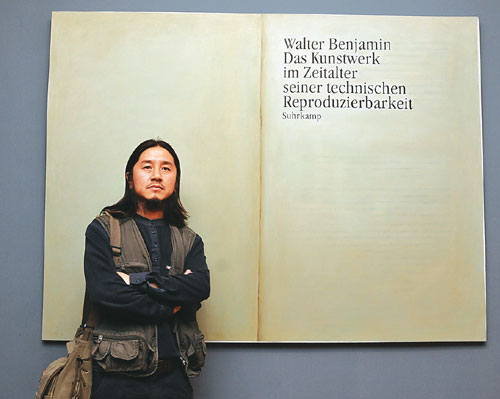


Newman Huo
WHEN the German artist duo Empfangshalle and filmmaker and artist Thomas Adebahr visited Dafen Village in Longgang District for the first time in October 2006, they were amazed to find the village was a big workshop for the reproduction of Chinese and European paintings. They decided to collaborate on an art project to respond to the Dafen Village phenomenon.
Now, as the result of their collaborative work, the art exhibition, “The Benjamin Project — a Visual Specimen of Dafen Village Reproduction,” is being displayed at He Xiangning Art Museum through Dec. 19.
The exhibition showcases a series of paintings which 38 painters from Dafen Village were commissioned to finish over the past four years by copying, page by page, a facsimile of the original edition of German philosopher Walter Benjamin’s essay, “The Work of Art in the Age of Mechanical Reproduction.” The essay was first published as a 38-page German booklet in 1936.
“When we first visited Dafen Village in 2006, it was very strange for us to find that there were so many painters in the village involved in reproducing Chinese and Western paintings for commercial reasons,” Adebahr said while attending the exhibition’s opening ceremony Saturday.
“For Western artists, we always believe that original works are important, and their copies are nothing,” said Adebahr.
Born in Cologne in 1957, Adebahr is now teaching fine arts at Kunsthochschule Berlin Weissensee (KHB), a school of art and design in Berlin. He has cooperated on different projects with Empfangshalle’s two members, Corbinian Bohm and Michael Gruber, for several years.
The Berlin-based Empfangshalle has long been interested in social sculpture and works that critically engage both site-specific details as well as social constructions of art.
Following their visit to Dafen Village, Adebahr and Empfangshalle decided to engage in a playful experiment on reproduced art using German philosopher and Marxist critic Walter Benjamin’s theories.
In his 1936 booklet, Benjamin provided a methodological interpretation of the concept of “reproduction” in the context of the industrial era as well as the reproduction and creation of works of art.
Benjamin believed the main component of traditional art was its uniqueness in the time and place it was created, and that such artworks were protected by a “halo.”
When the three-person team contacted Huang Haifan, their first painter from Dafen Village, to copy in oils the front page of Benjamin’s original booklet, Huang immediately turned down their proposal.
Huang, a painter from Anhui Province, began to set up his own workshop in Dafen Village in 2005. He claimed he was an original painter who only created his own pieces.
But after German artists raised the commission fee and promised to pay him 3,000 yuan for his work, Huang finally agreed to do his job as requested.
“That was the most expensive deal we paid. Later on, as we could find more painters from Dafen Village, we paid some of them only 200 yuan for their works,” said Adebahr.
The Benjamin project was first shown in Miami in the United States in March last year.
“But we feel more pleased that the project can be shown here to Chinese audiences in Shenzhen, an ideal place to display this complicated work and highlight cross-cultural implications between the East and the West,” said Adebahr.
Twins, triplets and quadruplets from the city were invited to attend the exhibition’s opening ceremony Saturday.
Dates: Through Dec. 19
Hours: 10 a.m.-5:30 p.m. Closed Monday
Add: He Xiangning Art Museum, Overseas Chinese Town, Shennan Thoroughfare, Nanshan District (南山区华侨城何香凝美术馆)
Metro: Hua Qiao Cheng Station (Overseas Chinese Town Station 华侨城站), Exit C
|

